What’s in the Task?¶
Some operators need to coordinate their work with other operators.
Table scan operators running in parallel need to pull splits from a shared queue.
The HashProbe operator needs to wait for the HashBuild operator to create a hash table.
Multiple HashBuild operators building different sections of the hash table in parallel need to coordinate to combine the pieces into one final hash table.
Exchange operators running in parallel need to pull data from shared remote sources.
Local exchange operators need to write and read data into shared data partitions.
Task enables coordination between these operators by maintaining a shared state.
Pipelines and Drivers¶
Task is responsible for converting a query plan into a set of pipelines consisting of multiple operators stacked on top of each other. See Plan Nodes and Operators for the mapping between plan nodes and operators. Each plan node with multiple sources introduces a new pipeline or pipelines. These plan nodes include HashJoinNode, NestedLoopJoinNode, MergeJoinNode, LocalMergeNode, LocalPartitionNode. Join nodes have two sources and introduce one new pipeline that ends at the right-side source. LocalMergeNode and LocalPartitionNode introduce one pipeline for each source. LocalPartitionNode is an exception as it may have a single source in which case it still introduces a new pipeline to allow for different parallelism before and after. Each pipeline may run multi-threaded and the number of threads used for each pipeline can be different.
Driver refers to a single thread of execution of a single pipeline.
Let’s look at a few examples.
A query plan with a HashJoinNode is converted into two pipelines. One pipeline contains a HashProbe operator. Another pipeline contains a HashBuild operator. HashBuild operator is the last operator in the pipeline. The number of threads processing HashBuild pipeline can be different from the number of threads processing HashProbe pipeline.
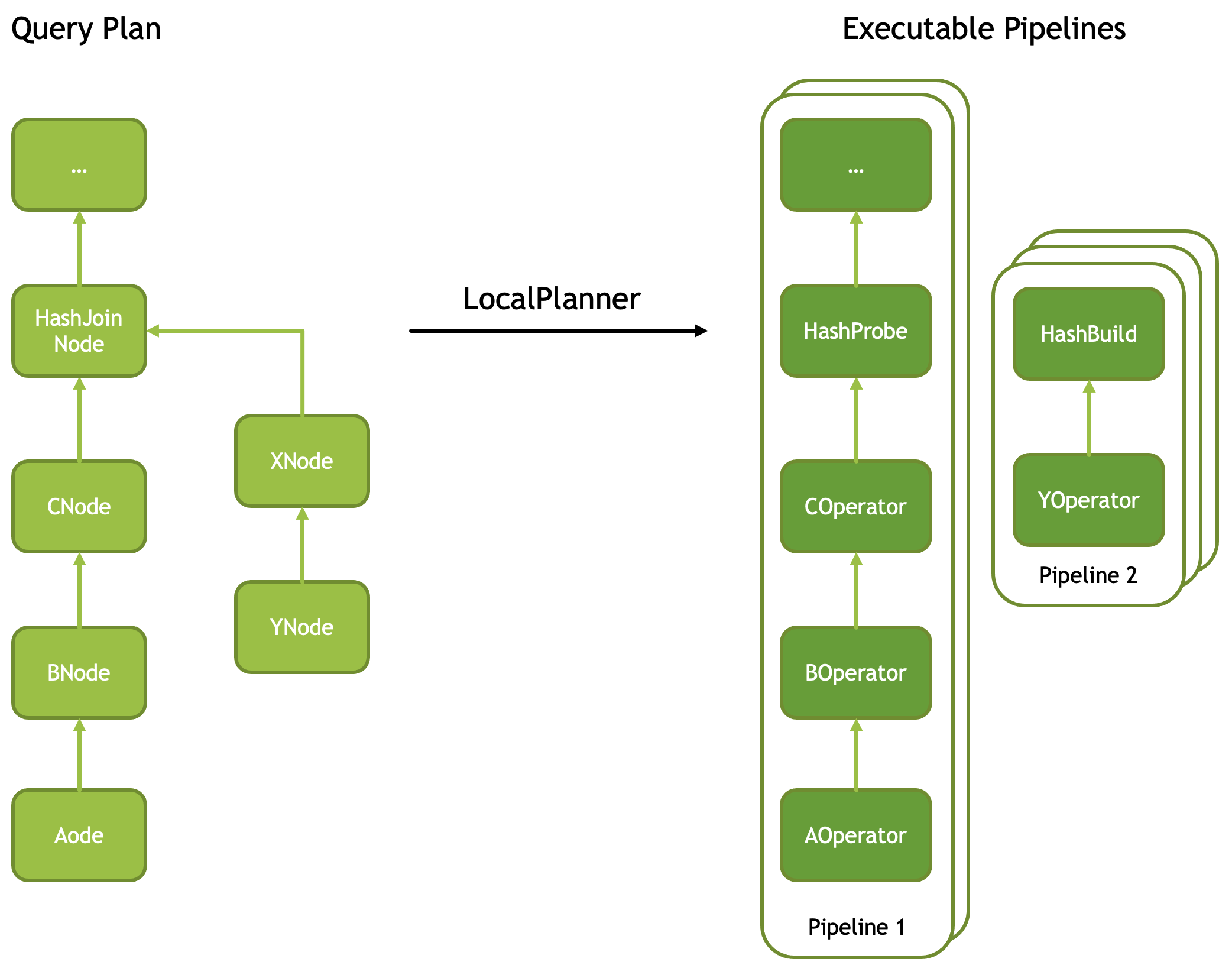
LocalPartitionNode is used to (1) repartition the data, or (2) gather data from multiple threads into a single thread, or (3) split the data produced by a single thread to allow for multi-threaded processing. A query plan with a LocalPartitionNode is converted into two pipelines: a producer pipeline that ends with LocalPartition operator and a consumer pipeline that starts with a LocalExchange. These pipelines may run with same or different parallelism allowing for N:1, 1:N and N:M local exchange.
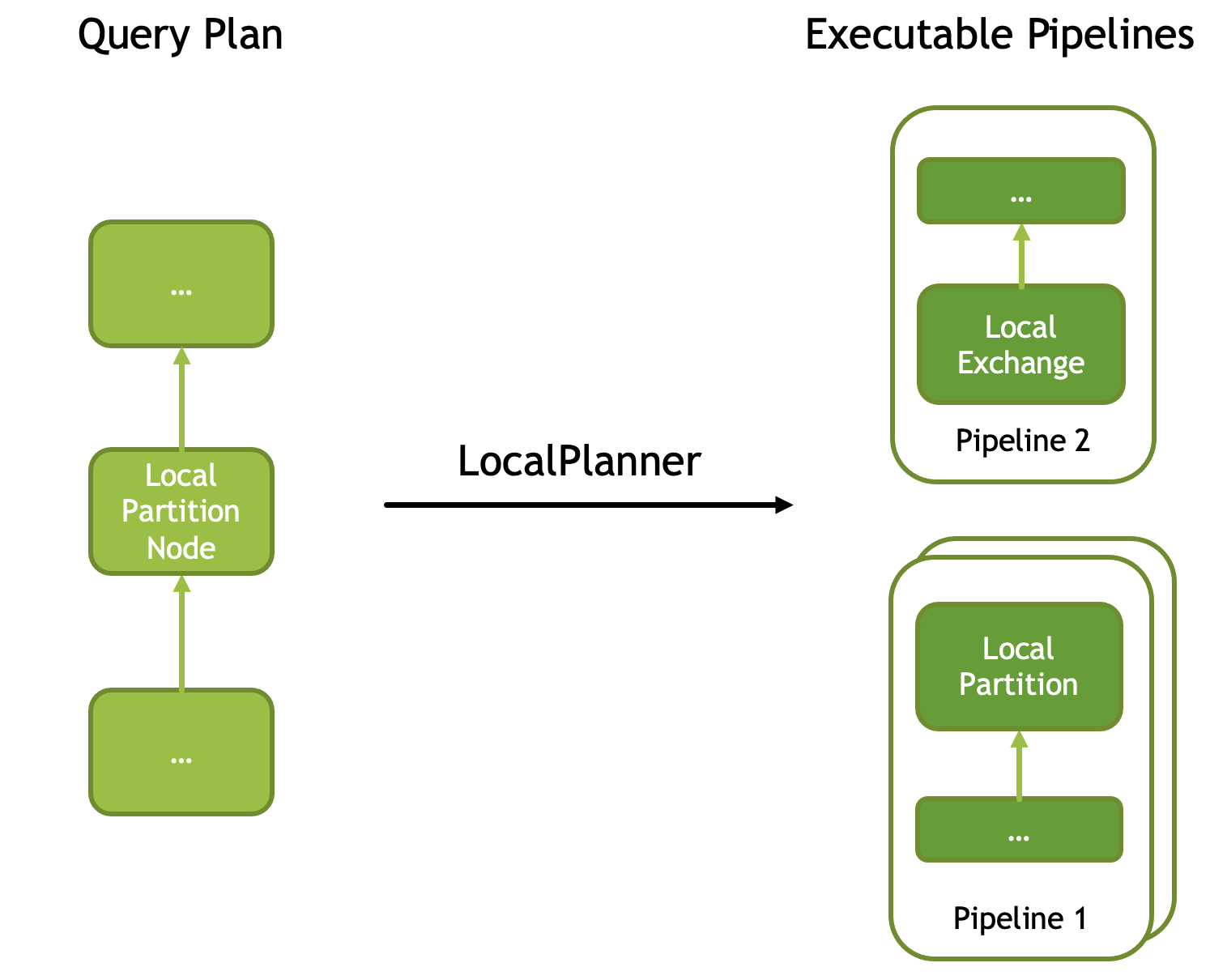
LocalMergeNode is used to combine multiple sorted inputs while preserving sortedness. A query plan with a LocalMergeNode with two sources is translated into three pipelines: one producer pipeline per source node and one consumer pipeline. Producer pipelines end with a CallbackSink operator. Consumer pipeline starts with a LocalMerge operator. A pipeline with a LocalMerge operator always runs single-threaded. Consumer pipelines produce sorted output and typically run single-threaded as well.
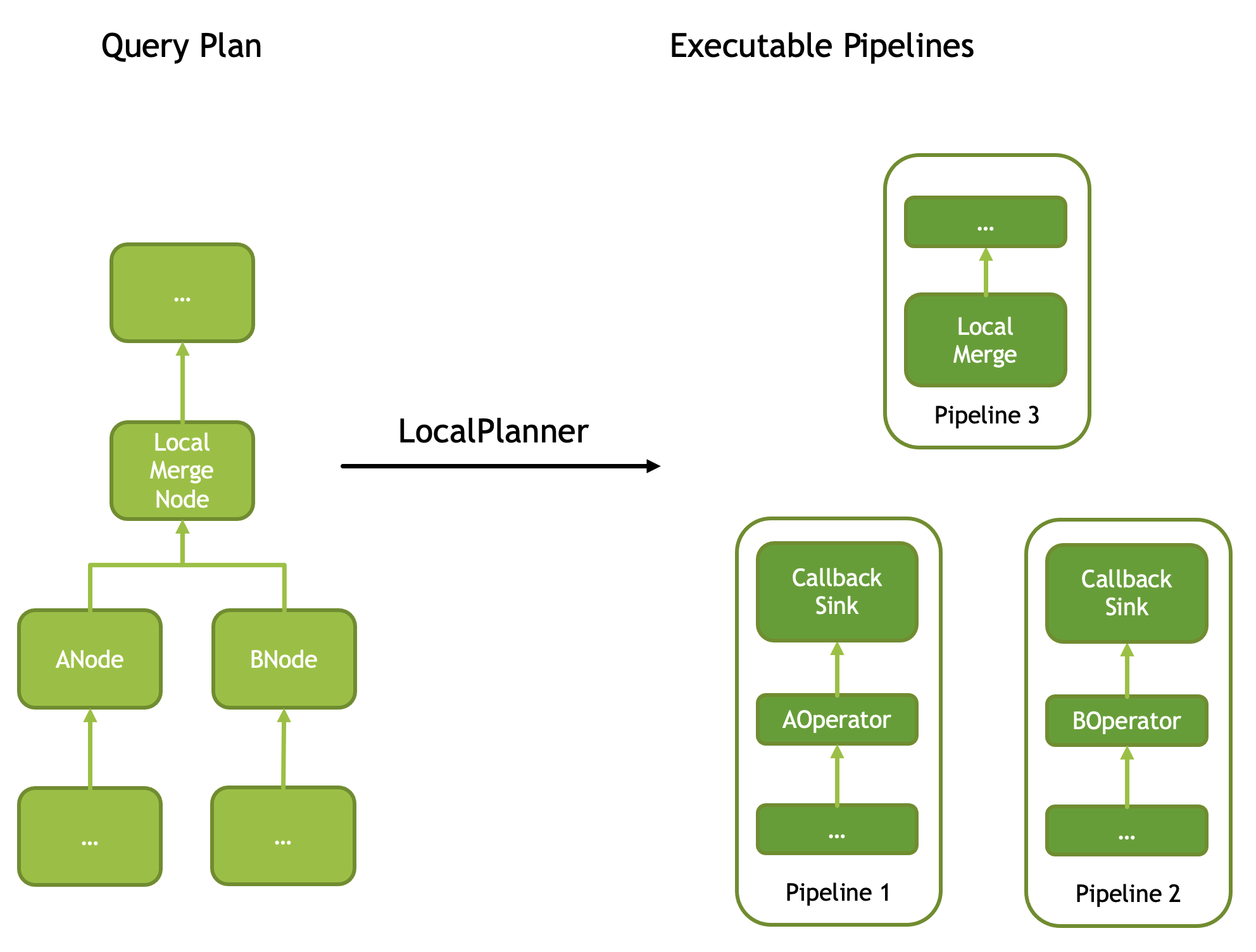
To summarize, a query plan is converted into multiple pipelines and each pipeline is executed using multiple Drivers. A given plan node is converted into one or more operators. Some plan nodes are converted into multiple Operators of different types. For example, TableScanNode is converted into multiple TableScan operators, one per thread of execution (Driver), while HashJoinNode is converted into multiple HashProbe operators and multiple HashBuild operators. The number of HashProbe and HashBuild operators may or may not match.
Task creates Drivers and Operators, then transfers the ownership of Operators to the corresponding Drivers. Each Driver is assigned a pipeline ID and a driver ID. Pipeline IDs are zero-based sequential numbers. Driver IDs are also zero-based sequential numbers scoped to a pipeline. Driver IDs are unique within a pipeline, but repeat across pipelines. Each Operator is provided with the plan node ID of the corresponding plan node and a DriverCtx specifying pipeline ID and driver ID. Operators of the same type with matching pipeline IDs are called peers. These operators are running concurrently in different Drivers. Each Operator is assigned a zero-based sequential operator ID unique within a Driver.
Splits¶
Task is responsible for receiving splits from the application, storing these, and providing access to the operators.
Splits can be added only for leaf plan nodes. Operators corresponding to leaf plan nodes fetch and process splits. These operators are called source operators and include TableScan, Exchange and MergeExchange.
Task::addSplit(planNodeId, split) API allows the application to add a split for a particular plan node. The application calls addSplit() API multiple times to add multiple splits for multiple plan nodes. Task::noMoreSplits() API allows the application to signal that it added all the splits. The Task will complete once it processed all the splits and received no-more-splits signal.
Task stores the splits in queues: one queue per plan node ID.
Task::getSplitOrFuture(planNodeId) API allows an operator to fetch a split from the corresponding queue for processing. This API returns a split if one is available or Future if the queue is empty, but no-more-splits signal hasn’t arrived yet. The Future completes when a split or no-more-splits message is received.
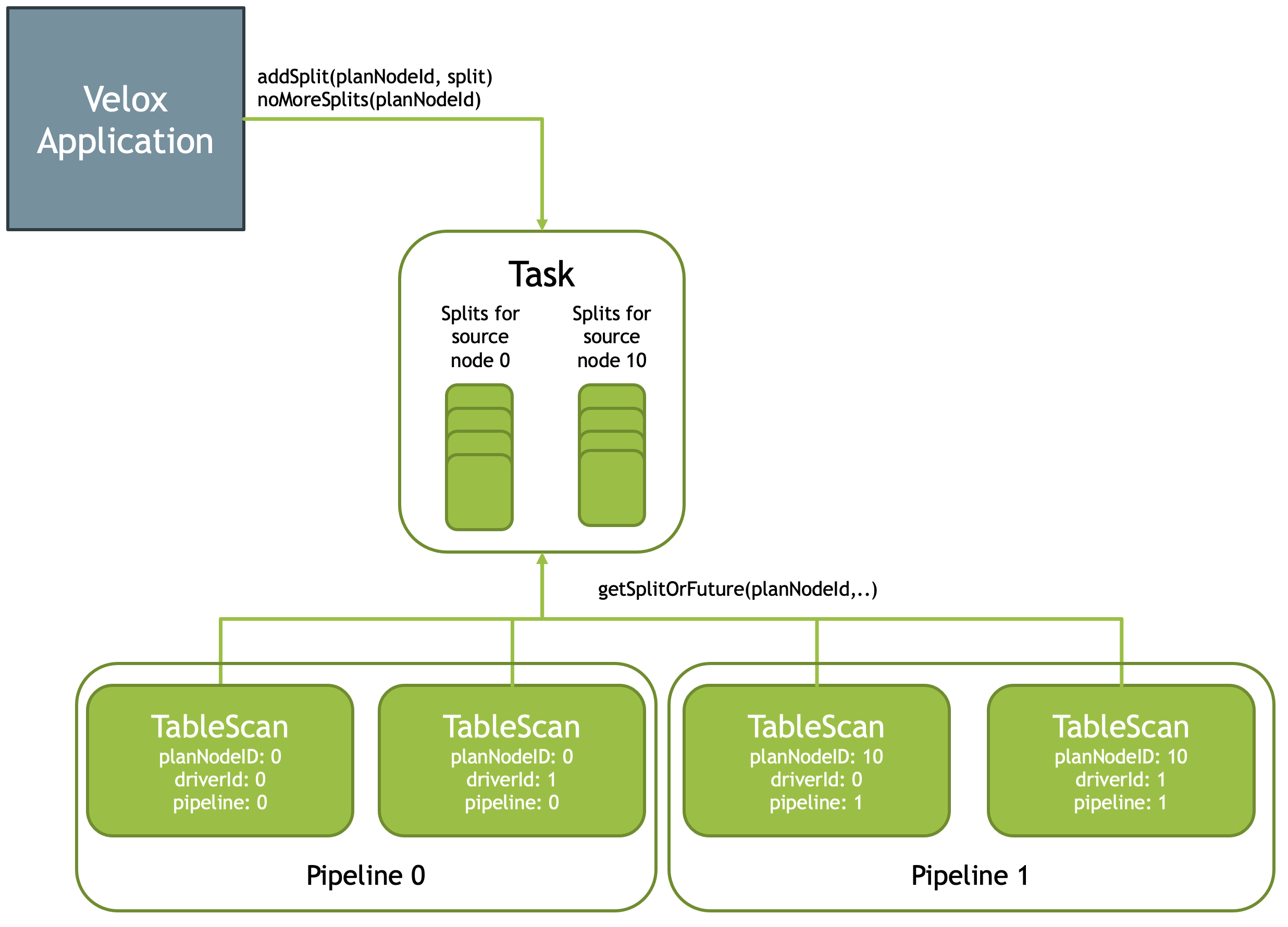
Join Bridges and Barriers¶
HashProbe operators need to wait for the corresponding HashBuild operators to create a hash table. For each HashJoinNode and NestedLoopJoinNode, the Task creates a bridge object, either HashJoinBridge or a NestedLoopJoinBridge. HashProbe and HashBuild operators use Task::getHashJoinBridge() API to get access to a shared bridge. HashBuild operator adds the hash table to the bridge. HashProbe operator fetches the hash table from the bridge. Similarly, NestedLoopJoinProbe and NestedLoopJoinBuild operators use Task::getNestedLoopJoinBridge() API to access a shared bridge to pass the build-side data to the probe-side.
HashBuilder operators running in parallel need to coordinate among themselves to wait until all are finished processing input to combine the results into a single hash table. When an operator finishes processing, it calls Task::allPeersFinished() API which returns false for all but the last operator. Last operator receives true and is responsible for assembling the hash table and sending it over the bridge to the probe side.
Task::allPeersFinished() API uses BarrierState structure to maintain state to know which operator is the last one.
Similarly, NestedLoopJoinBuild operators running in parallel use Task::allPeersFinished() API to choose a single operator to combine the results and send them over the bridge to the probe side.
In addition, in case of RIGHT and FULL OUTER join, HashProbe operators use Task::allPeersFinished() API to choose a single operator that would emit build-side rows with no match after all probe rows have been processed.
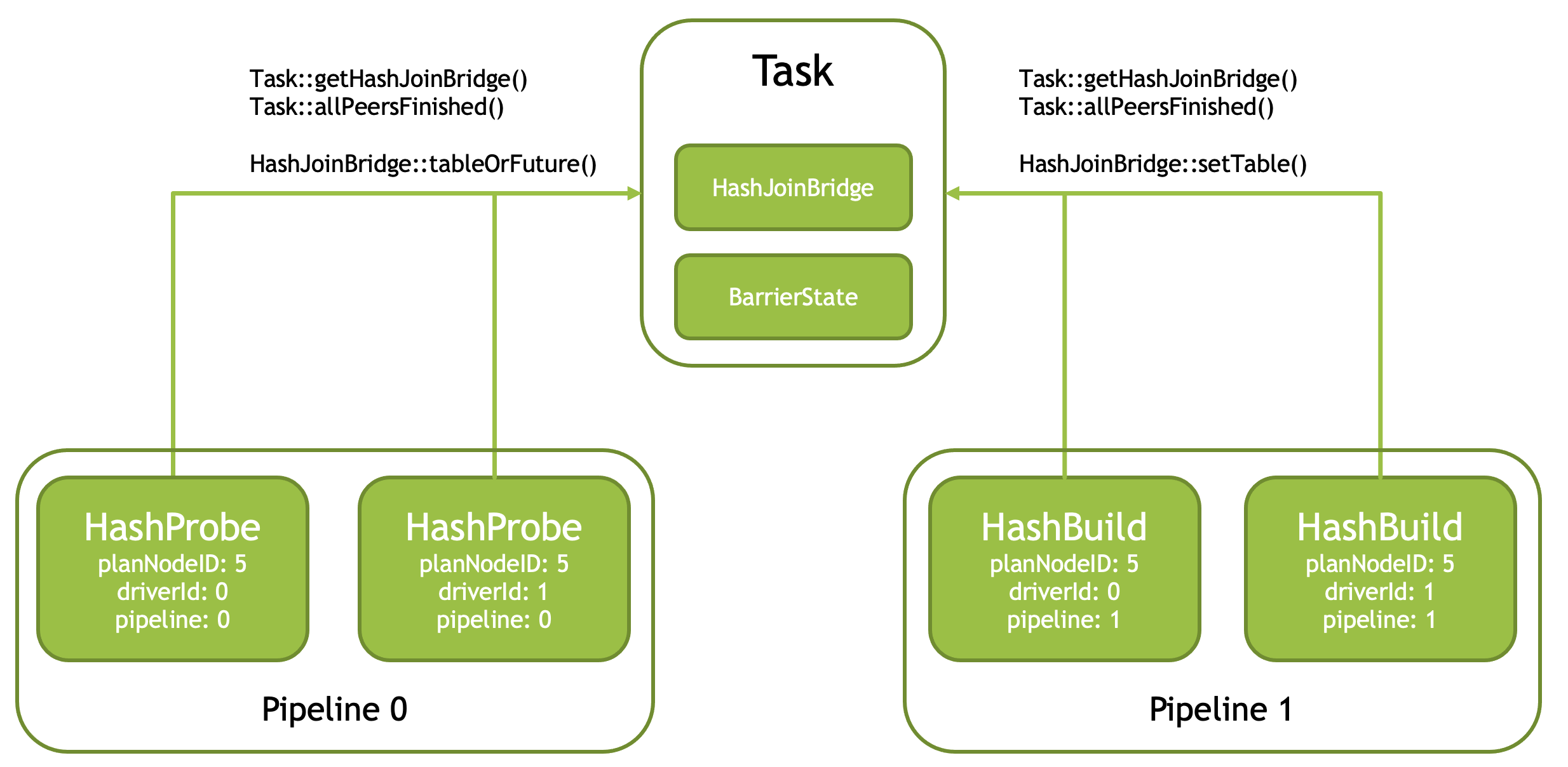
Exchange Clients¶
Exchange operator is designed to fetch a single partition of data from multiple remote workers. The exact mechanism of how to fetch the data is not included in the Velox library and expected to be provided by the application. The application implements an ExchangeSource and an ExchangeSource::Factory. The factory takes a string identifying the remote worker, a partition number, an instance of the ExchangeQueue and returns an instance of ExchangeSource that can fetch partition data from the remote workers and put that data into the provided queue.
ExchangeClient is responsible for creating ExchangeSources and maintaining the queue of incoming data. Multiple Exchange operators are pulling data from a shared ExchangeClient, each operator receiving some subset of the data.
A single Exchange operator (with driverId == 0) is responsible for fetching splits from the Task and initializing the shared ExchangeClient using task ID information found in the splits.
Task is responsible for creating and storing shared ExchangeClient instances, one per ExchangeNode. Task is passing the reference to the shared ExchangeClient for the corresponding ExchangeNode when creating Exchange operators.
The following diagram shows the first Exchange operator (driverId == 0) fetching splits from the Task and initializing ExchangeClient, then all Exchange operators fetching data from the shared ExchangeClient. For each split, ExchangeClient creates an ExchangeSource which pulls data for a single partition (#15 in the diagram) from a single upstream task. All ExchangeSources pull data for the same partition, but from different upstream tasks. The queue in ExchangeClient is used to accumulate the data for partition #15 from all the upstream tasks and distribute it among multiple Exchange operators allowing for parallel processing.
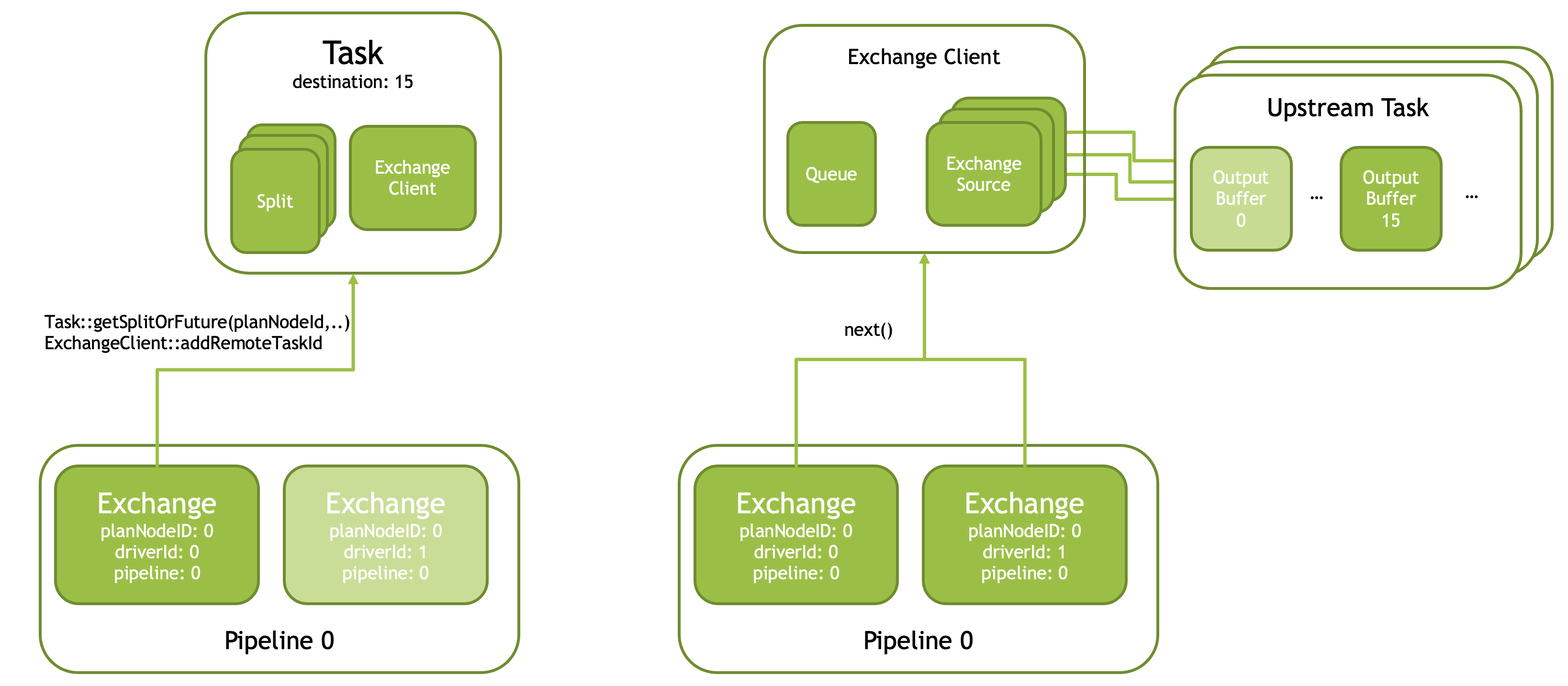
MergeExchange operator is similar to Exchange operator, but it receives sorted data from multiple workers and must merge the data to preserve sortedness. This operator must run single-threaded and therefore doesn’t require any shared state to be maintained in the task.
Local Exchange Queues¶
Local exchange is used to change parallelism or re-partition data between the pipelines. The exchange consists of a LocalPartition operator installed at the end of the producing pipeline, a LocalExchange installed at the source of the consuming pipelines and one or more LocalExchangeQueues that accumulate data. LocalExchangeQueues are shared among multiple LocalPartition and LocalExchangeQueues operators and therefore must be stored in the Task.
For each LocalPartitionNode, Task creates multiple LocalExchangeQueues, as many as the number of threads used to run the consuming pipeline. LocalPartition and LocalExchangeQueues operators use Task::getLocalExchangeQueue() API to get access to shared queues to read and write data to. LocalPartition operator partitions the data and puts it into LocalExchangeQueues. LocalExchange reads data from a single LocalExchangeQueue.

Local Merge Sources¶
LocalMerge operator is similar to LocalExchange, but it receives sorted data from multiple threads and must merge the data to preserve sortedness. This operator must run single-threaded. It uses Task::getLocalMergeSources() API to get access to LocalMergeSource instances the producing pipeline is writing to. For each LocalMergeNode, Task creates multiple LocalMergeSource instances to match the parallelism of the producing pipeline.
Merge Join Sources¶
MergeJoin operator needs a way to receive right-side data. It relies on the Task to create a MergeJoinSource and install a CallbackSink operator at the end of the right-side pipeline to write data to the MergeJoinSource. MergeJoin operator uses Task::getMergeJoinSource() API to get access to the MergeJoinSource() to read right-side data from.
Extensibility¶
Velox allows applications to define custom plan nodes and operators and also custom join node with it’s own join bridge and operators. These operators can access splits and use barriers as these constructs are generic and not tied to any particular plan node or operator. Exchange clients, local exchange queues and local merge sources as well as merge join sources are not generic and therefore not available to custom operators.
Summary¶
Task is responsible for maintaining shared state and enabling coordination between operators. The shared state consists of:
Splits
Join bridges and barriers
Exchange clients
Local exchange queues
Local merge sources
Merge join sources
Each piece of shared state is associated with a particular plan node. Operators use plan node IDs when accessing shared state. Custom operators have access to splits and barriers. Other pieces of shared state are not available to custom operators.